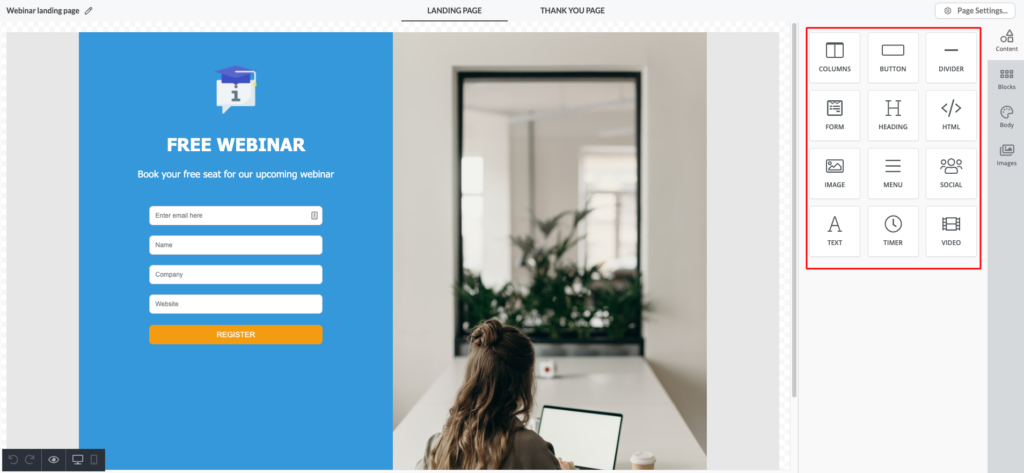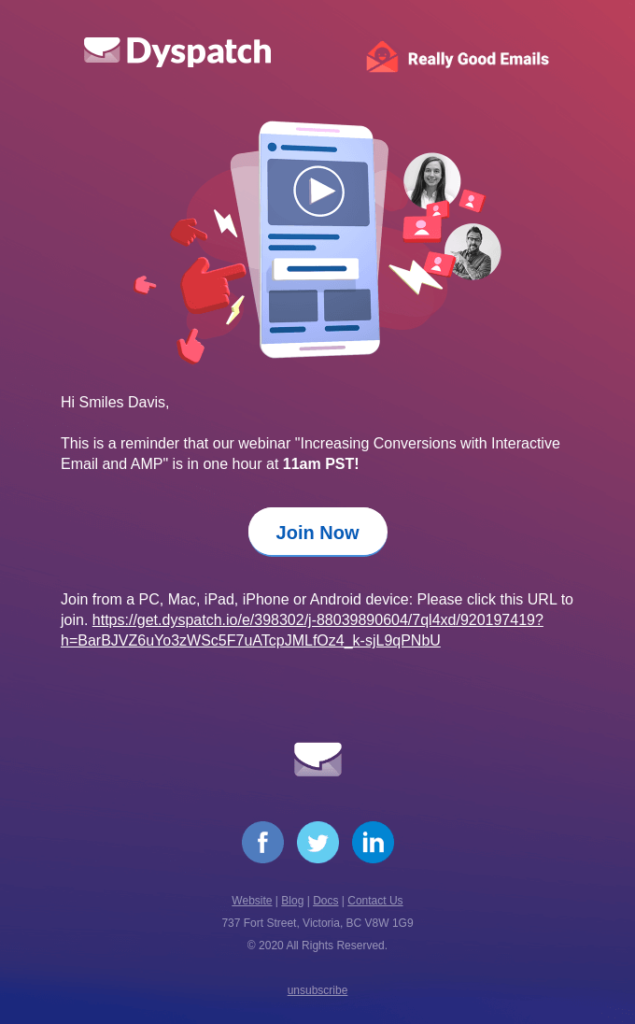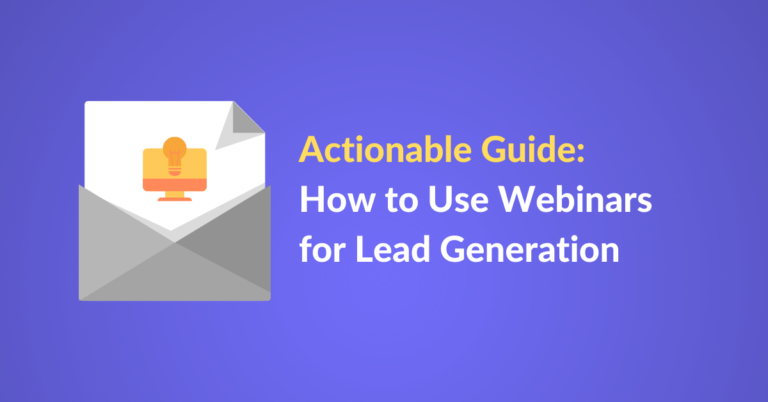Boosting lead generation is critical for the success of any business, regardless of its industry or niche. Without a constant influx of new potential customers, your company would have no way of staying afloat.
Even if you’re comfortable with the size of your business and have no expansion plans whatsoever, you cannot rely solely on your return customers for a stable revenue stream. You need to ensure that you have thought-out lead generation tactics that drive results.
And one of the best and more popular tactics is creating webinars.
They’re a type of evergreen content that can help you establish your brand as an industry leader. They can help you reach out to wider audiences, pique their interest, improve their engagement levels, spread your brand awareness, and increase lead generation and conversion.
If you want to find out how you can use webinars to your advantage, stick around. We’ll go over some of the major benefits of launching webinars and provide you with a thorough guide on how you can get started with your very first webinar campaign. So, let’s get to it.
What Are Webinars?
You take a seminar, hold it online, and you get a webinar – simple as that!
It’s a detailed presentation that’s ideal for both B2B and B2C companies as it allows you to share your knowledge and expertise with the world.
Whether you want to introduce new products to your existing customers, reach out to wider audiences and explain what your business has to offer them, or connect with potential business partners and present the benefits of your partnership, you can use webinars to do so.
An hour-long webinar enables you to explain in detail every aspect of your business that you deem relevant to your audiences. It allows you to share insights that boost engagement and offer real value to the viewers.
Unlike blog posts, embedded explanation videos, or dedicated FAQ pages, a short webinar allows you to start two-way conversations with your audience members in real-time. You can engage directly with your viewers, start discussions with them, and connect with them on a whole new level. Best of all – none of you have to leave the comfort of your home to participate in a webinar.
All you have to do is find a suitable webinar platform with high-quality video and audio, create an email invitation, and deliver your webinar from wherever you have an internet connection.
As long as you’re providing relevant information and trying to connect with your audiences truly, you could enjoy great success with your webinars.
Webinars Are Successful for Lead Generation
If you want to wow your viewers and boost lead generation and conversion, you need to commit and deliver high-quality content. And that takes time and effort – perhaps more than you’d be willing to invest. So, this begs the question – why would you want to rely on webinars if they’re so demanding?
The simple answer is because they’re effective.
- A single webinar can get you over 1,000 qualified leads (99 Firms)
- Average webinar registrant-to-attendee conversion rates are from 35% to 45% (99 Firms)
- Morning webinars are 93% more successful (Letter.ly)
- Q&A sessions are seen as 81% better (Letter.ly)
- 91% of B2B professionals rank webinars as their favorite content format (Ring Central)
- 54% of B2B professionals attend webinars weekly or daily (Ring Central)
- Webinars convert from 5% to 20% of attendees into buyers (Ring Central)
- 37% of marketers list webinars as a source of revenue (Ring Central)
- The average attendee stays on the webinar for 52 minutes (Daniel Waas)
- 84% of webinar attendees join them to stay updated on industry developments (SEJ)
While there are many lead generation methods and tactics, only few deliver such measurable results as webinars. Naturally, you’ll enjoy the best results if you focus on quality, relevance, and value. If your webinars don’t deliver relevant, quality content that brings value to audiences, you won’t have such great success.
Webinars Help Build Credibility
Whether you’re running a B2B or B2C company, webinars can help you build credibility and boost brand awareness.
Webinars are an excellent opportunity for sharing your skills and expertise with the rest of the world. You wouldn’t be able to hold a successful webinar without being a master of the topic you’re covering. So, your attendees will look to you for answers and solutions to some of their most pressing problems.
By providing insights and sharing ideas, you’ll be positioning your brand as a reputable source of knowledge and information. You’ll show why you’re the leader in your niche and why your viewers can have confidence in your brand. This free information-sharing helps build credibility and set your brand on a path to success.
What’s more, your webinar won’t be about sharing theoretical knowledge only if you include Q&As at the end. By enabling your audiences to ask you questions and providing insightful, relevant answers, you’ll display your expertise and let your audiences see your brand’s actual value first-hand.
Focus on thought leadership, engage your audiences, and offer solutions to their unique problems and pain points. No other tactic can help you shape your brand’s reputation quite like this.
Capture Quality Leads
It’s one thing generating leads and quite another generating quality leads. Quality leads are the people who are much more likely to take you up on your offers and start doing business with you. Quality leads are the ones that’ll provide enviable ROI and push your company forward. Quality leads are the ones you’re looking to acquire.
Lead generation tactics like social media campaigns or paid Google ads can certainly help you expand your reach. Random internet users will surely notice your name, maybe even look up your business to find out more details about your organization. But while these tactics can boost your lead generation, they won’t offer such great conversion rates.
Webinars will. They attract quality leads that are much more likely to convert.
If a person wasn’t interested in your brand, or at the very least in the topic you’ll be covering in your webinar, they won’t register. No one wants to waste an hour of their time sitting in on a random lecture that has nothing of value to offer them.
Your webinar attendees are automatically quality leads that are ready to take action. They’re ready to solve their problems, and they’re looking for someone who can help them. And it just so happens that it’s your company that can help them the most.
Webinars Help Find Partners
Finding lucrative partners through webinars can be a breeze. Considering just how effective webinars are for lead generation and conversion, every brand wants to cash in on them. But, since creating webinars is not quite as effortless as many would like, few brands opt to make them alone.
So, if you have an idea for a webinar, finding a non-competing partner who offers complementary products or services can be relatively straightforward. You’ll share the costs, the workload, and the benefits.
You’ll improve your exposure, make use of your partner’s email list to attract relevant audiences, and boost your conversion rates even further.
8 Steps for Generating Leads With Webinars
Now that you understand everything you could gain through webinars, it’s time to learn how you can actually use them to generate leads.
1. Find your target audience
As with any lead generation tactics, you need to find and define your target audience before anything else. If you don’t know who your preferred attendees are, you cannot create a useful webinar that drives them in and gets them involved.
Without knowing your target audience, their needs, wants, pain points, and problems, you cannot come up with a relevant topic, develop the proper tone of voice, or even send out a promotional email with high open rates.
So, first and foremost, do your research and get to know your target audience.
2. Define your goals
The next step is defining your goals. You can start with broad ideas and determine what you want to achieve with your webinar. Do you want to improve lead generation? Get better conversion rates? Increase sales?
Once you have your ultimate goal, find out how you can achieve it through your webinar. If your target audience consists of brand new leads who are barely familiar with your brand, your goal would be to introduce them to your company. You’ll need to devote more time to introductions or Q&As.
If your target audiences are your competitor’s clients you’d like to convert, you’ll need to devote more time to highlighting your USP (Unique Selling Points).
Defining your goals will help you shape your webinar and improve its effectiveness, so don’t forget this critical step.
3. Find the right partners
Partnering up for a webinar is in your best interest, but only if you can find the right partners who make sense for your brand. Partnering up with competitors can be an interesting tactic, but you’d risk losing all your qualified leads to them. Partnering up with a company that’s not relevant to you or your audiences will simply leave everyone confused and make it more difficult for you to develop a suitable topic.
So, find a partner who makes sense for your industry and niche—someone who offers complementary products and services and who can be valuable to your target audiences. And make sure that the partner is a reliable company with a pristine reputation. Otherwise, your brand reputation could suffer by association.
4. Create a strong landing page
Webinars aren’t typically open for all. Attendees need to register and provide you with relevant information such as names, email addresses, and more. To streamline the whole registration process and get as many attendees as possible, you’ll want to create a strong landing page.
It should contain all the necessary information about your webinar – what it’s about, who the hosts are, and why your website visitors should join it. Include a strong call to action and highlight the value your webinar has. If possible, include a few FAQs about the webinar, the main points you’ll discuss, and even add an explainer video.
Don’t overpromise, however! You’ll want to make your landing page look enticing, but if you overpromise and underdeliver, you’ll only lose your qualified leads and damage your reputation.
Here is an example of how to build a webinar landing page in Automizy.

5. Create excitement & promote
You won’t get many webinar attendees if you don’t let the world know you’ve actually scheduled a webinar. You need to promote it and create some excitement around it.
The simplest, most effective way to promote your webinar is by creating a custom email and reaching out to your target audiences. Your emails should be concise, to the point, and include a link to your webinar’s landing page where your audiences can register.

Of course, you’ll also want to promote your webinar through your newsletter, blog posts, and social media channels. Notify your loyal customers and ask them to refer a friend, rely on Google ads, and have your sales team promote the webinar to their contacts.
Don’t forget to send out reminders before the webinar. Send out a reminder email a week before the event, a day before, and when the webinar starts to ensure nobody forgets about it and that not attending is a choice, not an accident due to forgetfulness.
6. Find the right type of webinar
There are several different types of webinars you can create – educational, Q&A, demo, workshop, panelist discussion, masterclass, and more. When choosing the right type for your needs, you’ll have to keep your target audience in mind.
If your audience consists of completely new leads who aren’t familiar with your brand and products, holding a Q&A webinar could be ineffective (although including a Q&A at the end of the webinar is still a must!). They wouldn’t know what questions to ask since they don’t really know what your company is doing.
If your audience is mostly existing clients who’ve been using your products/services for years, an educational webinar that explains your company’s benefits and introduces current products would offer no value.
So, carefully consider your audiences when choosing your type of webinar.
7. Prepare for the event
To prepare for the event, you’ll need to create a central framework for your webinar. Divide the webinar into individual sections with time limits:
- Introductions (∼5min)
- Brand story (∼10min)
- Valuable information (∼30min)
- Your offer (∼5min)
- Q&A (∼10min)
Keep your audience engaged throughout your webinar. Every once in a while, ask a question, set up a poll, or request some feedback. If you solely hold a monologue, many audience members could lose interest. So, keep your webinar focused on them.
8. Do a necessary follow-up
Your webinar can help you generate leads, but to boost your conversion rates, you’ll need to do a follow-up. The best way to go about it is by creating an email campaign that helps you nurture your leads.

A thank-you email right after the webinar is over is a must. You might want to share additional information that’s relevant to the webinar’s topic or a brief reminder of what the webinar was about – main points discussed and conclusions made.
You’ll need to continue nurturing your leads if you want to reap all the benefits of using webinars for lead generation.
The Bottom Line
Webinars are a powerful tool that can help you connect with new audiences and boost your generation and conversion rates. When done right, they can set your company on a path to success.
To create an effective webinar, you’ll have to:
- Find your target audience
- Define your goals
- Find the Right Partners
- Create a Strong Landing Page
- Create Excitement & Promote
- Find the Right Type of Webinar
- Prepare for the Event
- Do a Necessary Follow-up
Get started and see for yourself just how effective webinars can be.

